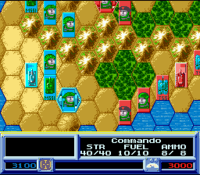Super Conflict
| Super Conflict | |
|---|---|
 North American cover art | |
| Developer(s) | Manley & Associates |
| Publisher(s) | Vic Tokai[1] |
| Designer(s) | Douglas A. Deardorff[2] |
| Artist(s) | Jonathan Sposato |
| Composer(s) | Robert Ridihalgh[3] |
| Platform(s) | Super NES |
| Release date(s) | |
| Genre(s) | Strategy |
| Mode(s) |
Single-player Multiplayer (2 players) |
Super Conflict is a turn-based strategy video game that was released for the Super NES. It is the sequel to Conflict for the NES.
Gameplay

The player assumes the role of a commander of combined forces. The scope of each battle and the number and variety of military units available to fight with, increases as the game progresses. The game was marketed as gulf war themed, but gameplay is more consistent with potential cold war scenarios. There are two modes: short (which allows players to plan strategic battles without any tactical consequences) and long (which allows all units to participate in up to four rounds of constant warfare).[5] The blue forces are armed with American weapons while the red forces are armed with Soviet-made weapons.
Super Conflict is a military simulation game played on a hex map in which players try to capture the opponent's "Flag Tank" or "Flag Ship". The map consists of various terrain tiles with movement and defense modifiers. For example, bridges and deserts lower the defense ratings of occupying troops; hills and mountains provide additional defenses but require more fuel to move through. There are over 55 different scenarios and 16 two-player scenarios.[6]
References
- ↑ Andy Slaven, Video Game Bible, 1985-2002 (Trafford Publishing, 2002), 169.
- ↑ "Designer/artist information". MobyGames. Retrieved 2011-12-27.
- ↑ "Composer information". SNESMusic.org. Retrieved 2011-12-27.
- ↑ "Release information". GameFAQs. Retrieved 2008-10-01.
- ↑ "Super Conflict game overview". allgame. Retrieved 2011-12-27.
- ↑ "Super Conflict". Nintendo Power. 46: pp. 20–23. March 1993.